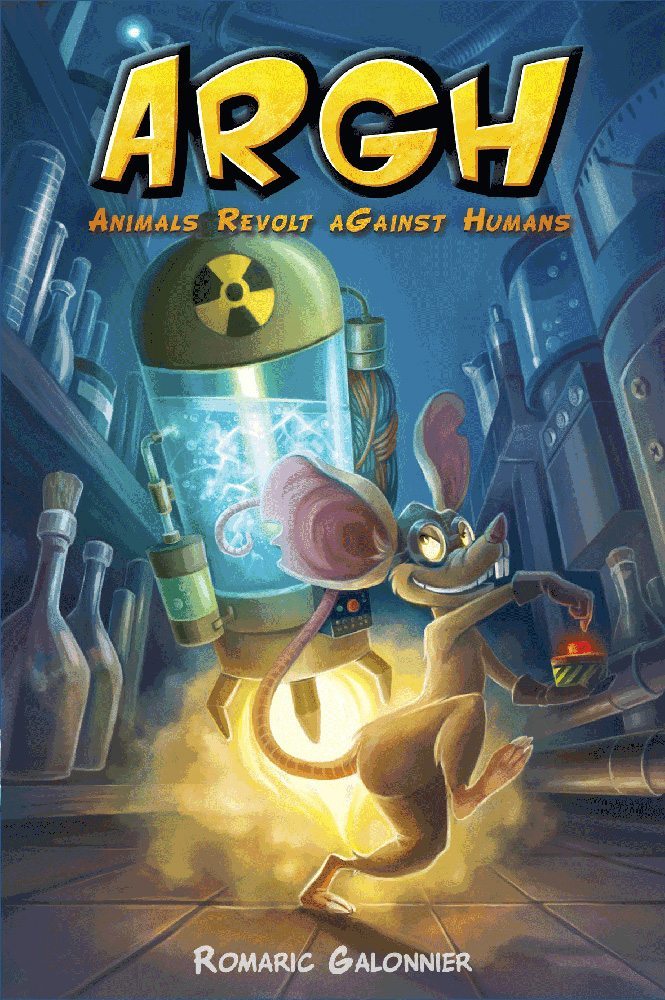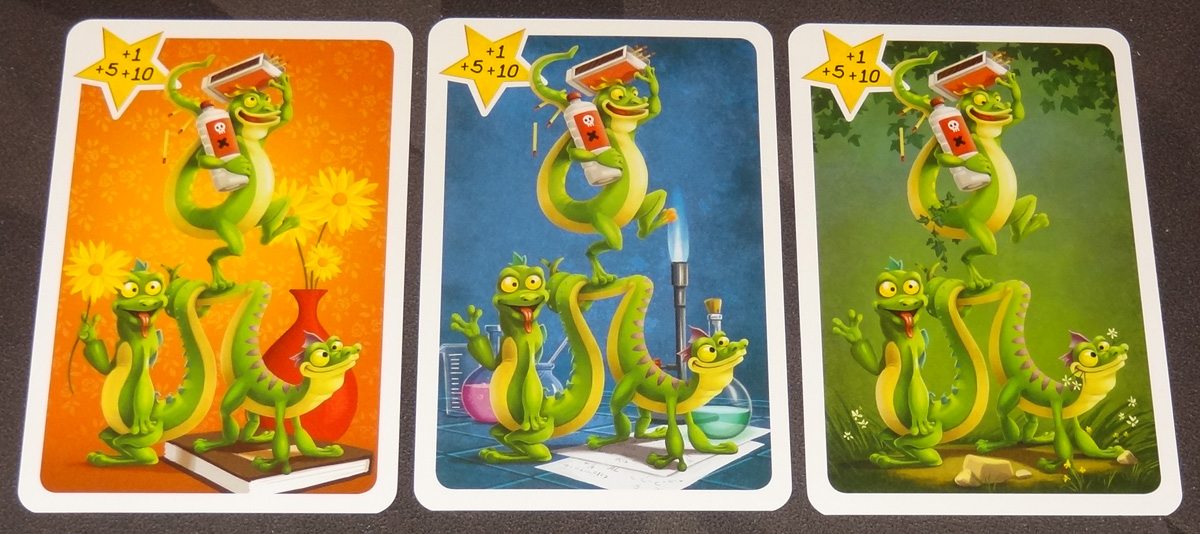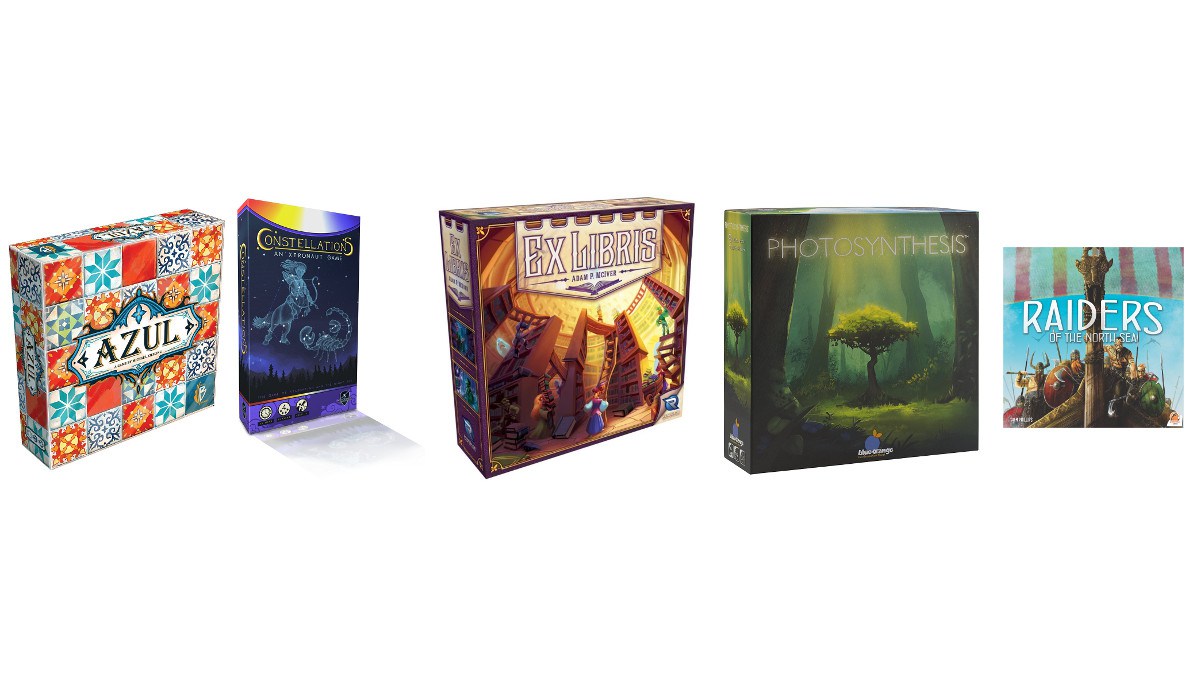 Led by an escaped lab rat, a band of animals works to destroy the lab. Who will be the leader of ARGH: Animals Revolt aGainst Humans? (Hey, nobody said animals were great with acronyms.)
Led by an escaped lab rat, a band of animals works to destroy the lab. Who will be the leader of ARGH: Animals Revolt aGainst Humans? (Hey, nobody said animals were great with acronyms.)
What Is ARGH?
ARGH is a light bluffing game for 2 to 4 players, ages 8 and up, and takes about 5–15 minutes to play. It retails for $16.99 and is in stores and online now. It was originally published by Blue Cocker Games in France, and was brought to the US by Dude Games. The gameplay is simple enough for kids to learn; thematically it has a bit of cartoon violence with animals trying to blow up a lab.

ARGH Components
Components are pretty simple for ARGH: just 24 cards (8 from each of 3 locations), and 4 player aid cards.
The cards represent three different locations: a home, a lab, and a garden, with different illustrations and colors on the backs and fronts to help distinguish them. Each location has a different mix of animals, humans, and other cards. The illustrations are cartoony, showing the various animals gathering fireworks, explosives, vials of unknown liquids, and other ingredients for mayhem—as well as a few of the humans the animals are revolting against. Each card has an icon in the top corner that shows whether it’s good (a star) or bad (a red diamond), along with its value or special icon. Most of these are fairly self-explanatory.

The player aid cards show all of the cards in the deck, so you can guess what you might get from any given deck. All of the cards are large cards, showing off the artwork. One odd thing is that the player aid cards are a little bit bigger than the game cards, and it’s not entirely clear why. The box has a small cardboard insert to hold the game cards in place, but it seems unnecessary. Personally, I think the game would have worked just as well with standard sized cards in a much smaller box, though kids may enjoy the oversized cards and artwork.

How to Play ARGH
You can download a copy of the rulebook here.
The Goal
The goal of the game is to acquire two of the three bomb components, or—if nobody succeeds at that—scoring the most points.

Setup
Setup is very simple: Shuffle the three location deck separately. Remove one card from each deck without looking and return them to the box, and set the three decks in the center of the table. Choose a player to go first.
Gameplay
On your turn, you have two choices: draw a card from a location, or steal a face-down card from another player.
When you draw a card from a location, you look at it secretly and then must either place it face-down in front of you, or offer it to another player (face-down). That player must decide to accept the card or give it back to you without looking at it—then the card is turned face-up in front of its owner.
If you steal a face-down card from another player, you turn it face-up and place it in front of you.
(Note: once a card is face-up in front of a player, there is no way to steal it.)

Game End
There are two ways for the game to end: If any player gets 2 bomb parts face-up in front of them, they automatically win. Or, if any of the location decks runs out, everyone else gets one more turn. In this case, once all the turns are over, everyone reveals any face-down cards in front of them. At this point, if anyone has two bomb parts, they win.

If nobody has two bomb parts, then you add up points. Many of the animals give you points, and humans subtract points. There are also some other special cards that come into play. If you have an odd number of spies (animals who are working for the humans), then you lose, regardless of your score. The angry hamster discards a red diamond card, and the scientist discards a star card. The mosquitoes switch the sign of one of your cards, positive to negative or vice versa.

The player with the highest score wins, with ties going to the player with the single highest value card.
Why You Should Play ARGH
ARGH is a bluffing game in which you don’t actually have to lie at all. Or, to be more specific: you never have to make any claims about a card. You simply offer it to another player, or keep it to yourself, and you let other players draw conclusions about which cards are good and which cards are bad.
It does remind me a little bit of Cockroach Poker and Barnyard Roundup, both of which involve secretly peeking at something and then offering it to another player. But in both of those cases, you make a claim about what it is, and then the other player must guess whether you’re telling the truth or bluffing. In ARGH, you don’t have to say anything at all about what a card is when you offer it or keep it, which makes it a little easier for players who aren’t comfortable with (or just aren’t good at) bluffing.

It’s a pretty quick, light game: each player’s turn is quite brief, and it will go even faster if players keep drawing from the same location, since the game end is triggered if a location pile runs out. But that doesn’t mean you don’t get to make some meaningful decisions throughout the game. The big question, of course, is how to get rid of cards you don’t want and how to keep cards you do want. If you draw a negative card, is it better to keep it face-down, hoping that somebody will draw it and get stuck with it? Or is it better to offer it to somebody else—and thus risk getting stuck with it when they turn it down? The same questions arise when you draw a good card—particularly if it’s a bomb part.
Anything that is face-down in front of you when the game ends will be yours, so sometimes you do want to keep good cards when you draw them, in the hopes that the game will end before anyone takes them. And, in fact, if you keep drawing cards from the same location, you can end the game more quickly.

Since everyone has a reference card, you can tell what isn’t in a deck anymore based on the face-up cards in front of everyone. But there’s also one card missing from each deck, so there’s always a little bit of incomplete information. You know that each location should have a bomb part, but there’s no guarantee that it’s there. Likewise, if you get stuck with a spy and you’re looking for a second to cancel it out, you never know for sure that you’ll be able to find it. Looking around the table, you can often do a little bit of deduction, but usually it’ll only get you so far before you just have to take a leap of faith one way or another.
My middle daughter hit upon a strategy that did seem hard to beat, if the other players don’t catch on soon enough: she just accepted every card that was offered to her, and always stole face-down cards from other players if there were any available. What we discovered was that, if the other players kept offering cards to her (instead of other players), then she would eventually wind up with most of the cards—and whether she had the bomb parts or not, she was likely to have the highest score because on average there are more positive cards than negative cards. The only hitch to her plan would be the spies—but in some cases if she got the “discard a red diamond” angry hamster card, she had a bit more control over the number of spies she ended up with. It’s a strategy that won’t keep working if you use it every time you play with the same group, but she ran away with the victory at least twice before we realized we needed to counter it. (Shame on the rest of us, I guess!)
ARGH is a compact game centered on one fairly simple mechanic, but it uses that mechanic well. The theme is pretty goofy and isn’t all that important to the gameplay—it just adds a bit of visual flavor to what could have been an abstract numbers game. It’s really quick to teach, so I’ve been able to break it out and start playing right away without a lot of rules explanations, which is also nice. I do wish it accommodated more than 4 players (as some of the other similar bluffing games do). For me, ARGH is a game that will likely be something I’ll start off a game night with or play when I’ve just got a little bit of time available, but isn’t meaty enough to be the focus of a game night.
If you like the idea of bluffing games but you’re not great at lying, ARGH might just give you a chance at winning. Check your local game store to join the revolt!
Click here to see all our tabletop game reviews.
If you’d like to stay up-to-date with all of our tabletop gaming coverage, please copy this link and add it to your RSS reader.
Disclosure: GeekDad received a copy of this game for review purposes.





